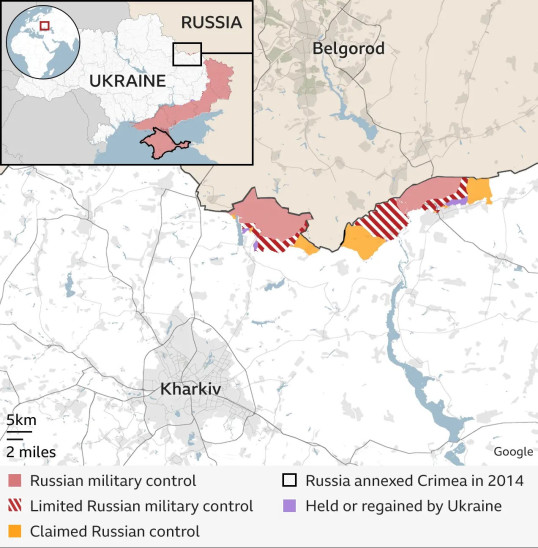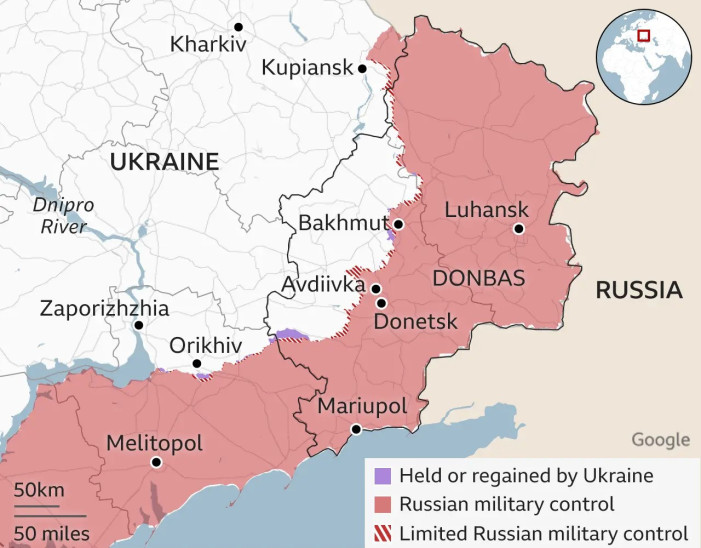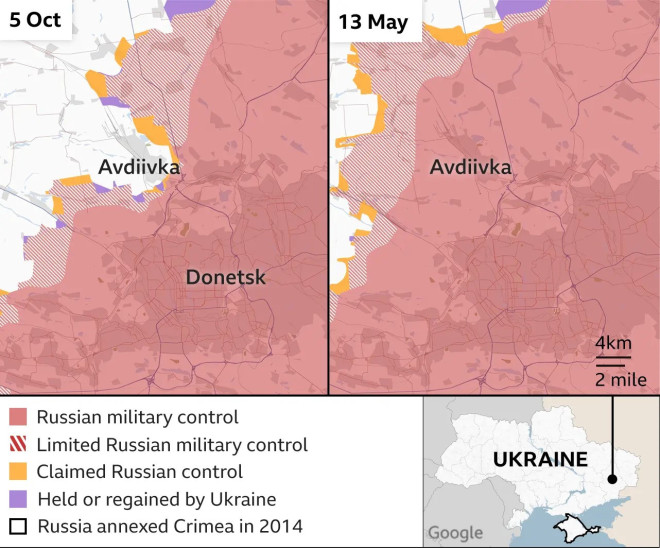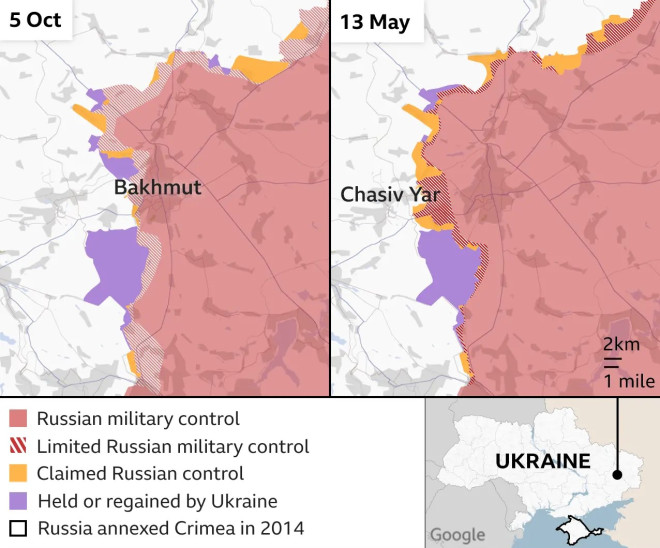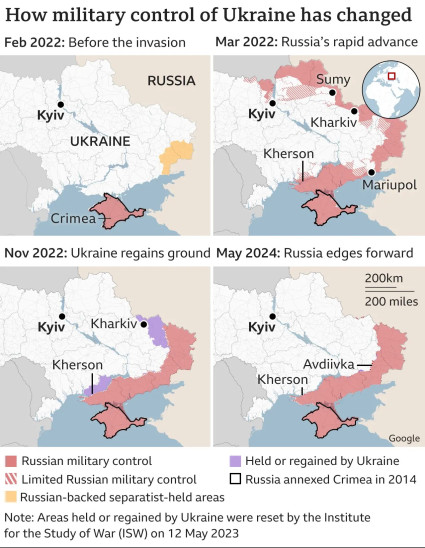The maps show the progress of the war in Ukraine and the movements of the two enemy forces
In February 2022, Russia invades Ukrainian territory, surprising the West and Kiev. Very quickly, Russian troops occupy the whole Donbass and in essence they leave her Ukraine with one and only outlet to the Black Sea, via Odessa. Western support for Ukrainian forces is limiting the Russian advance. Russian forces, in recent months, have made small gains in territory, while the Ukrainian side has gone on the counterattack by crossing the northeastern Russian border.
The following maps highlight the history of the Russian-Ukrainian war and show how the situation has developed in the territories of Ukraine, as reported by the BBC.
Ukrainian forces counterattack and invade Russian territory
Ukrainian troops made a surprise raid on the Russian border in early August, advancing 30 kilometers into the Russian territory of Kursk.
About 200,000 people evacuated the Belovsky and Krasnaya Yaruga border regions on orders from the Russian government. Vladimir Putin condemned the Ukrainian attack, calling it a “big provocation”.
A week later, Ukraine’s top general claimed 1,000 square kilometers of Russian territory was under Ukrainian control, although analysts said the actual scale was less.
Kursk and Belgorod announced that they are on high alert.
The current governor of Kursk, Alexei Smirnov, said Ukrainian forces captured 28 communities, but Ukraine’s president put the number at 74.
The counteroffensive was seen as an attempt to force Russia to move its forces out of eastern Ukraine and thereby take some of the pressure off Ukrainian forces there. At the same time, the Ukrainian side aims to improve its chances of concluding peace on terms favorable to itself.
The Russian raid north of Kharkiv
In early May 2024, Russian forces crossed the international border into northern Ukraine, invading its second largest city, Kharkiv. Several villages were captured and thousands of civilians fled.
Russia’s main offensive has long focused on the eastern Donetsk region, but this was the most significant ground assault since the start of the war and further stretched Ukraine’s front line of defense.
The Russian attack came after the end of a four-month period in which the US did not supply weapons to Ukraine, due to a deadlock in the US Congress.
The impasse was broken in late April when the US moved forward with a $61 billion aid package that included supplying Ukraine with missiles, artillery and air defense systems.
Ukraine ultimately “held firm” despite Kharkiv being repeatedly bombed by Russian warplanes. Thus, Kharkiv remained out of range of Russian artillery.
Russia is advancing deeper into the east
The Kharkiv invasion was independent – as it has a long distance – from Russia’s front line of attack on the eastern front, where raids continue and go even deeper as of October 2023.
Eastern Ukraine has been a bone of contention between the two countries since 2014, when Russian fighters seized large swaths of the eastern regions of Donetsk and Luhansk.
Russia’s biggest asset is manpower, and it has shown a willingness to sacrifice soldiers to gain a few yards at a time.
About 1,200 Russian soldiers were killed or wounded each day in May and June, the highest rate since the start of the war, according to Western officials.
Meanwhile, hoping to help relieve depleted frontline troops, Ukraine lowered the minimum age for conscription from 27 to 25.
Russia had a notable success in the town of Avdiivka, where Ukrainian troops withdrew in February after months of fighting.
It marked the biggest shift in the more than 1,000-kilometer (620-mile) front line since Russian troops captured the nearby town of Bakhmut in May 2023.
In the event of a successful Ukrainian counteroffensive, Avdiivka could act as Ukraine’s gateway to the Russian-controlled city of Donetsk, but that opportunity has now passed.
Almost the entire population of Avdiivka, more than 30,000 people have fled and the city itself has been almost completely destroyed.
Russian forces now control what’s left of the city and continue to push westward, with their sights set on the Ukrainian-held towns of Pokrovsk and further north on Chasiv Yar, which is about 10 kilometers west of Bakhmut.
The areas around Bakhmut remain a flashpoint and have seen some of the heaviest fighting of the war.
Although Ukraine gained some ground in the surrounding areas over the summer, Russian forces have since advanced around the city.
Two and a half years of war
Russia’s invasion began with dozens of missile attacks on Ukrainian cities before dawn on February 24, 2022.
Russian ground troops moved quickly and within weeks were in control of large areas of Ukraine and had advanced into the suburbs of Kiev.
Russian forces were bombarding Kharkiv and had occupied territory to the east and south as far as Kherson, while surrounding the port of Mariupol.
How has the ownership of Ukrainian lands changed since then?
Russia, however, without expecting it faced very strong Ukrainian resistance on all fronts resulting in heavy logistical damage. Russian troops were suffering from shortages of food, water and ammunition.
Ukrainian forces have been quick to acquire weapons from the West, such as the Nlaw anti-tank system, which has proven highly effective against the Russian advance.
By October 2022, the picture had changed dramatically and, having failed to capture Kiev, Russia had completely withdrawn from the North. The following month, Ukrainian forces recaptured the southern city of Kherson.
Since then, the battle has been fought mainly in eastern Ukraine with Russian forces slowly gaining ground after a months-long effort, while they have lost at least 50,000 soldiers and possibly more.
Source :Skai
With a wealth of experience honed over 4+ years in journalism, I bring a seasoned voice to the world of news. Currently, I work as a freelance writer and editor, always seeking new opportunities to tell compelling stories in the field of world news.


